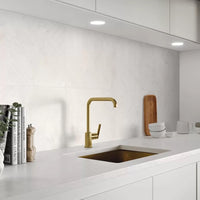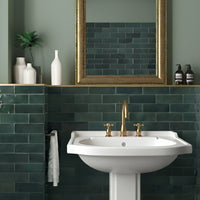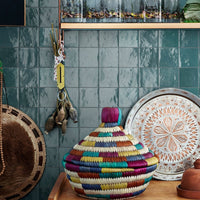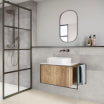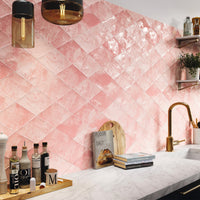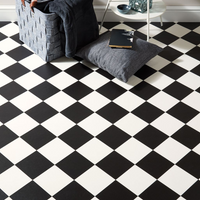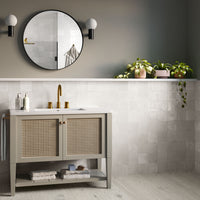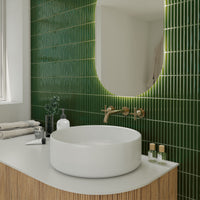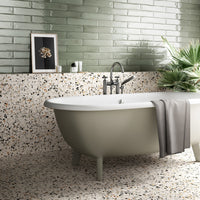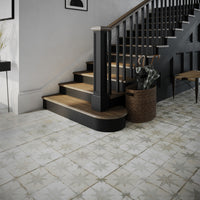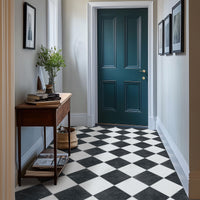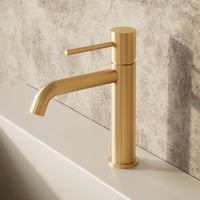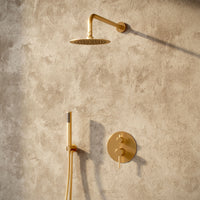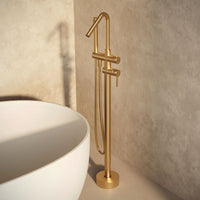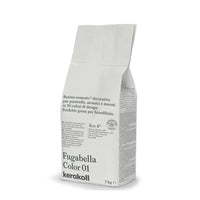It's safe to say that wood tiles aren't just for floors - these days, you'll also find them covering the coolest walls. Interested in the trend? Then read on to discover more.
While we love our flat matt paint, textured walls continue to be one of those enduring trends in interiors. The material of choice right now is wood - and we're not talking about traditional tongue-and-groove panelling. Instead, it's wood effect wall tiles that are decking out the designer homes. They're a modern way to add a contemporary edge to an often rustic material. In this post, we'll show you how to use them in your very own space.
Feature Shower Walls

Using slatted wood tiles as a feature wall in a shower is a brilliant design choice that effortlessly combines functionality with aesthetics. In this wet-room, slatted oak tiles grace the wall while concrete-style tiles adorn the floor, creating a stunning contrast that perfectly embodies Japandi style. This fusion of Japanese minimalism and Scandinavian simplicity results in a bathroom that exudes tranquility and sophistication.
The slatted oak tiles not only bring warmth and natural beauty to the space but also provide texture and depth to the shower area. The concrete-style floor tiles, on the other hand, offer durability and easy maintenance. This blend of materials adds character to the room without overwhelming its serene atmosphere.
To get the look at home, pair our Forest Oak wall tiles with Motion Light on the floor. It's essential to choose simple yet high-quality brassware that won't distract from the quiet overall aesthetic. This combination of wood, concrete and black brassware will help you create a a spa-like oasis in your home - an escape from the hustle and bustle of everyday life.
Contemporary Bathrooms

As we've seen, slatted wood tiles will transform any bathroom space into a haven. In the previous example, the tiles were laid horizontally to help emphasise the width of the room. However, slat wood panels are traditionally laid vertically, as shown above, where two individual feature walls are created. This helps to make the smaller space feel more open and expansive.
And although the slatted panels are very similar, the overall look is quite different - with a warmer and more contemporary feel. This is achieved by pairing the wall tiles with wood effect floor tiles, a luxurious free-standing bath and an uber-modern tall washbasin. The rest of the room is kept relatively simple with just a few accessories on show.
As with the floor, the wall tiles are made from porcelain and are much better suited to steamy spaces than veneered wood panels. There's no concern about swelling or warping due to moisture - these walls will continue to look gorgeous and graceful for years to come. Again, it's a marriage of practicality and aesthetics - a design choice that will really stand the test of time and trends.
Rustic Bathrooms

While slatted wood is undeniably a contemporary trend, it can also seamlessly fit into a more traditional bathroom, as evidenced by this charming design.
Here, wood-effect slats harmoniously coexist with warm stone-effect floor tiles and ceramic wallpaper, creating a captivating blend of old-world charm and on-trend design. This aesthetic is especially well-suited for a period property, where it exudes a cosy yet stylish ambiance that's perfectly balanced between traditional and contemporary style.
And what sets this rustic bathroom apart is how it captures attention without succumbing to overly ornate details. There's no intricate mouldings, dado rails or chintz to overwhelm. Instead, everything works in harmony, with the slatted tiles acting as a versatile backdrop for the modern bathtub and the reclaimed basin furniture. The result is a bathroom that's inviting, warm, and timelessly appealing, with the wood tiles that subtle star of the space. You can achieve a similar look by pairing Forest Walnut with Tuscany Ivory on the floor.
Period Planks

Wood slat tiles and walls might be a match made in heaven, but that doesn't mean you can't also use normal wood tiles on your walls. Far from it! While it might not be the norm, it's no less eye-catching, as this elegant take on a period bathroom shows. Here, the wooden floor tiles gracefully extend onto the walls, creating a contrasting feature to the clawfoot bath.
A modern interpretation of classic wood panelling, it's both stylish and practical - the porcelain tiles won't stain or warp, no matter how wet they get. When laid vertically, the length of the tiles - 120 cm - provides a perfect height for a shelf to store soap, shampoos and a few favourite trinkets. You can get the same look at home by using Living Oak.
Charming Chevrons

And in a similar vein - sorry, grain - you could also run chevron wood tiles from your floor and onto your wall, as shown above. Again, it's an unexpected design twist but one that works, introducing subtle pattern that's sure to catch the eye and ignite a conversation.
What sets this arrangement apart is the unorthodox alignment of the chevron tiles. Instead of being fixed in the usual zig-zag pattern, they're laid in straight, uninterrupted lines - a deviation that only adds to the allure. An innovative take on slatted wall panels, you can carry this style on living rooms walls, in your bathroom or even over the front of your kitchen island.
To recreate this effect at home, we'd recommend using Avalon Oak with a light grey grout. This will emphasise the joints that little bit more than in the image, without overshadowing the overall look.
A Modern Twist

This captivating bathroom seamlessly marries sophistication with subtle, intricate details. The foundation of the design rests on the juxtaposition of elements - rustic timber tiles sprawl across the floor, grounding the space in warmth, while sleek mint tiles ascend the walls, exuding modernity. And sitting on a raised plinth, a freestanding bathtub takes centre stage, subtly accentuated by recessed lighting. Behind this, the feature wall tiles are elegantly embossed with a chevron pattern.
Take a second look, however, and it's the humble shower niche that steals the spotlight, unexpectedly decorated with wood effect planks. A surprising contrast to the minimal wall tiles, they transform the walk-in shower to the focal point of the room. By using the same tiles in the niche as on the floor, the whole room is connected - it's a subtle detail that infuses rustic texture into an otherwise modern space.
Slatted Splashbacks

While most of the areas we've looked at have been bathrooms, there's no reason why you can't use wood effect wall tiles in other rooms at home. Kitchen walls might feel a little out-there, but take it from us - if you adorn your splash-backs in slatted wood tiles, you'll have a design decision that speaks volumes about your interior style.
In this kitchen, slat wood tiles are paired with pristine quartz worktops and sleek grey cabinets. The tiles help to soften the look, turning what could be a clinical room into a warm and inviting space - contemporary design with a rustic twist, in other words.
Compared to white metro tiles, it's an unconventional choice. However, like a subway tile, slat wood tiles will outlive any passing trend and will give your space an aesthetic that's stylish, eye-catching and truly timeless.
